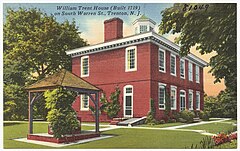William Trent House
William Trent House Museum | |
 William Trent House in 2019 | |
 | |
| Location | 15 Market Street, Trenton, New Jersey |
|---|---|
| Coordinates | 40°12′45.7″N 74°45′57.7″W / 40.212694°N 74.766028°WCoordinates: 40°12′45.7″N 74°45′57.7″W / 40.212694°N 74.766028°W |
| Area | 5.2 acres (2.1 ha) |
| Built | 1719 |
| Architectural style | Georgian |
| NRHP reference No. | 70000388[1] |
| NJRHP No. | 1799[2] |
| Significant dates | |
| Added to NRHP | April 15, 1970 |
| Designated NHL | April 15, 1970[3] |
| Designated NJRHP | May 27, 1971 |
The William Trent House is a historic building located at 15 Market Street in Trenton, Mercer County, New Jersey. It was built in 1719 for William Trent and is the oldest building in Trenton.[4] He founded the eponymous town, which became the capital of New Jersey. It has served as the residence for three Governors. The house was added to the National Register of Historic Places and listed as a National Historic Landmark on April 15, 1970, for its significance as an example of Early Georgian Colonial architecture.[5]
Description[]
The William Trent House stands just south of downtown Trenton, on a landscaped parcel about 6 acres (2.4 ha) in size which is ringed in part by brick walls and stone and iron fencing. The lot is bounded by Market Street, an exit ramp of New Jersey Route 29, William Trent Place, and a parking lot serving the adjacent judicial facility. The house is a 2-1/2 story brick building, with a five-bay front facade and a hip roof crowned by a central cupola. Most windows are set in segmented-arch openings, with some butting against the dentillated cornice below the roof. The main entrance, a double door with a six-light transom window, is also set in a segmented-arch opening. The interior follows a central hall plan, with four chambers on each floor. Original surviving features include the main staircase, Dutch tiles in one of the fireplaces, and original woodwork in several rooms.[5]
History[]
The house was built on land purchased in 1714 by William Trent (c. 1653—1724), a Scottish immigrant who came to Philadelphia in 1682. The house was built as a summer house, but Trent moved in on a year-round basis in 1721, about the time he laid out the town that bears his name. The house had numerous private owners until 1929, when it was given to the city by Edward C. Stokes.[5]
During the summer of 1798, the federal government evacuated to Trenton to escape a yellow fever epidemic plaguing the temporary national capital, Philadelphia, Pennsylvania. Following Congress's adjournment in July (in Philadelphia), President John Adams spent the rest of the summer and most of the fall at his home in Quincy, Massachusetts. The Trent House housed federal offices until November, when the danger was deemed to have passed.[6]
Recently, the building has been undergoing renovation including a new visitors center, funded by a grant from the New Jersey Historic Trust.[4] It serves as a historic house museum.
Gallery[]
| Wikimedia Commons has media related to Trent House, Trenton. |

Postcard showing the house, and the gazebo

Historic American Buildings Survey photograph
See also[]
- List of National Historic Landmarks in New Jersey
- National Register of Historic Places listings in Mercer County, New Jersey
- List of the oldest buildings in New Jersey
- List of museums in New Jersey
References[]
- ^ "National Register Information System – (#70000388)". National Register of Historic Places. National Park Service. November 2, 2013.
- ^ "New Jersey and National Registers of Historic Places - Mercer County" (PDF). New Jersey Department of Environmental Protection - Historic Preservation Office. December 28, 2020. p. 17.
- ^ "William Trent House". National Historic Landmark summary listing. National Park Service. Retrieved 2009-08-25.
- ^ a b New Jersey Trust Grant
- ^ a b c Greenwood, Richard (June 3, 1975). "National Register of Historic Places Inventory/Nomination: William Trent House". National Park Service. With accompanying 5 photos
- ^ David McCullough, John Adams (New York: Simon & Schuster, 2001), pp. 507, 516.
External links[]
- Official site
- Historic American Buildings Survey (HABS) No. NJ-200, "Trent House, 15 Market Street (changed from 539 South Warren Street), Trenton, Mercer County, NJ", 41 photos, 1 color transparency, 20 measured drawings, 9 data pages, 4 photo caption pages
- "William Trent House". Historical Marker Database.
- "William Trent House (NHL)". Historical Marker Database.
- National Historic Landmarks in New Jersey
- Historic house museums in New Jersey
- Houses completed in 1719
- Biographical museums in New Jersey
- Museums in Trenton, New Jersey
- Houses in Trenton, New Jersey
- National Register of Historic Places in Trenton, New Jersey
- Georgian architecture in New Jersey
- 1719 establishments in New Jersey
- Historic American Buildings Survey in New Jersey
- New Jersey Register of Historic Places




